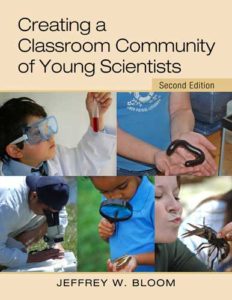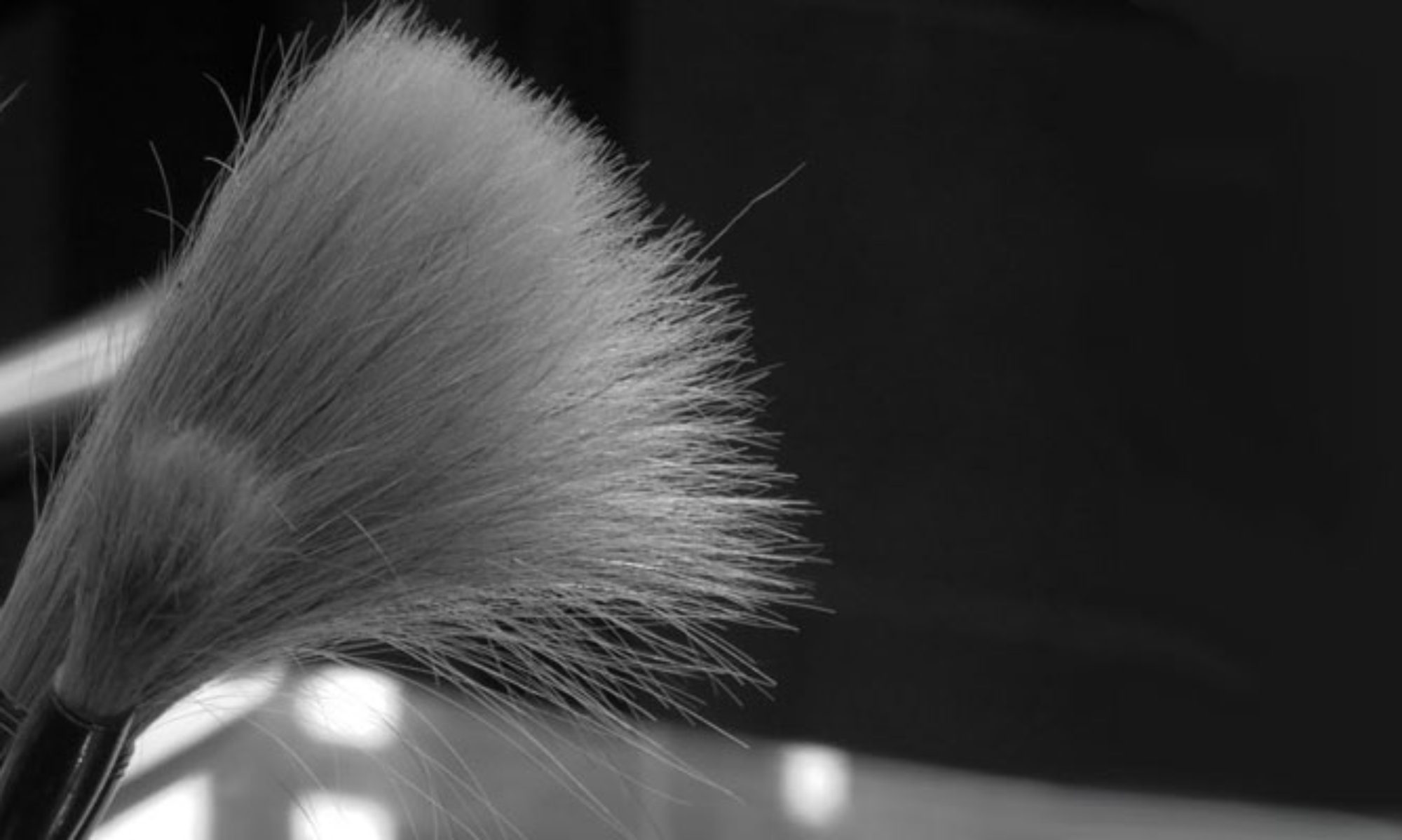Bloom, J. W. (2006). Creating a classroom community of young scientists (2nd ed.). New York: Routledge.
Purchase here:
• Better World Books • Abe Books UK • Indigo Books
 Creating a Classroom Community of Young Scientists helps teachers – both pre-service and in-service – to develop exciting science programs in their classrooms. This book provides the groundwork for designing and implementing a science program that takes into account the latest research in teaching and learning. It provides an approach that will capture children’s imaginations, stimulate their curiosity and create a strong foundation for their continued interest in, and appreciation of, science and the world in which they live. The book is designed to be user-friendly, and offers an approach to teaching science that is exciting for teachers as well.
Creating a Classroom Community of Young Scientists helps teachers – both pre-service and in-service – to develop exciting science programs in their classrooms. This book provides the groundwork for designing and implementing a science program that takes into account the latest research in teaching and learning. It provides an approach that will capture children’s imaginations, stimulate their curiosity and create a strong foundation for their continued interest in, and appreciation of, science and the world in which they live. The book is designed to be user-friendly, and offers an approach to teaching science that is exciting for teachers as well.
This thoroughly revised, second edition focuses on making inquiry more explicit both in terms of the process of inquiry and teaching in ways that capitalize on children’s curiosity and questions. New material has also been added on U.S. and Canadian science standards, as well as professional standards for teachers.
Creating a Classroom Community of Young Scientists provides teachers with the insight and tools they need to develop exciting elementary and middle school science programs. Bloom’s approach to science education is founded on the notion of democratic classroom communities, where students are responsible for and in control of their own and others’ learning. This approach, and the inquiry-based and activity-oriented learning methods it endorses, will stimulate children’s imaginations and create a strong foundation for their continued interest in science.
User-friendly and engaging, the book is supplemented throughout by real-life examples, questions for reflection, and suggested classroom activities that make science education exciting for the teacher as well as the students. This thoroughly revised and updated second edition contains a significant amount of new material, including new information on science education standards and a new chapter on the benefits of an inquiry-based teaching method fueled by children’s curiosity and questions.
Features include:
Sidebar reflective questions and suggested activities encourage the reader to further engage with the material covered in each chapter
Activities and teaching strategies are presented in relation to U.S. and Canadian science education standards
Real-life examples pulled from current issues and challenges in teaching elementary science
Table of Contents
Part 1. Getting Started
1 Introduction
1.1 Beginning the journey
1.2 Philosophy and theoretical framework
1.3 Goals and emphases
1.4 How to use this book
1.5 Some questions to consider
1.6 Two quotes to think about
2 Initial Explorations
2.1 Pond water investigation
2.2 Investigating earthworms
2.3 Nature walk
2.4 Moon study
2.5 Exploring light, lenses, and mirrors
2.6 Summary
Part II. Teaching Science for Children’s Meaningful Learning
3 Nature of Science
3.1 Introduction
3.2 Views of science: Scientists and thinkers about science
3.3 Activities
3.4 Examples of children’s ideas
3.5 Summary
4 Children’s Learning and Sense-Making
4.1 Constructivism
4.2 Social constructivism
4.3 Contexts of meaning
4.4 Categorization
4.5 Play
4.6 Complex learning
4.7 Summary of implications for teaching
5 Children’s Talk
5.1 The traditional approach to classroom discussions
5.2 An alternative approach to classroom discussions
5.3 An example of a classroom argument
5.4 Extending our understandings of how to work with children’s discussions
6 Teaching and Learning through Inquiry
6.1 Types of questions and inquiry
6.2 Patterns of inquiry in the classroom
6.3 A cycle of inquiry
6.4 Observational studies
6.5 Experimental studies
6.6 Inquiry and learning
7 Assessing Children’s Learning, Thinking, and Talk
7.1 Establishing goals
7.2 Some necessary background
7.3 The purpose of assessment
7.4 Some approaches to assessment
7.5 Observations and performance assessment
7.6 What to look for and keeping track
7.7 Additional issues of assessment as driven by curricular documents and national standards
7.8 A final activity
8 Planning and Implementing Instruction
8.1 Some basic guidelines and principles to consider
8.2 How and where to start
8.3 A simple model of planning – E-7
8.4 Instructional plans
8.5 Alternative sequencing for a restricted curriculum situation
8.6 Taking into account children’s ability levels (…but not selling them short!)
8.7 Teaching and working with children: Implementing instruction
8.8 Some example unit topics and themes
8.9 Yearly planning
9 Classroom as Community of Young Scientists
9.1 Developing the classroom as a community of learners, inquirers, and young scientists
9.2 Establishing a classroom community
9.3 Setting up your classroom
9.4 Working with children
9.5 Working with parents and the extended community
9.6 Working with yourself
10 Reflective Practice
10.1 Background to professional thinking and learning
10.2 An overview of reflection
10.3 Working with yourself
10.4 The focus of reflection
10.5 Reflection examples and activities
10.6 Dilemmas
11 Where to Go From Here: Participating in the Professional Community
11.1 Participating in the professional community
11.2 Continuing to learn about science
11.3 Continuing your professional development
Part III. Appendices
A Safety
A.1 Physical safety
A.2 Personal, psychological, and social safety
B United States Science Education Standards
C Canadian Science Education Standards
D Learning and Teaching for Complexity
D.1 Systems
D.2 Patterns, metapatterns, and other broadly connecting concepts
D.3 Teaching and learning for complex understandings
E More On Planning – Curriculum Units
E.1 More planning tools
E.2 Sample curriculum unit ideas
F Field Studies
F.1 Types of field studies
F.2 Planning an extended field study
F.3 Summary
G Sample Activities
G.1 Structures
G.2 Marble collisions
G.3 Pendulums
G.4 Balancing act
G.5 Batteries and bulbs
G.6 Construct a boat to hold a specific cargo
G.7 Forest or open field study
G.8 Exploring metapatterns
G.9 Challengers – Jumping into what scientists experience
H Data Collection and Analysis Techniques
H.1 Background
H.2 Collecting data
H.3 Analyzing data
H.4 Formulas and conversions
H.5 Summary
I Science Techniques
I.1 Collecting and keeping organisms
I.2 Science techniques and procedures
I.3 Science equipment and measurement
J Technology
J.1 Computers and the Internet
J.2 Photography
J.3 Video
J.4 Audio
J.5 Laboratory probeware
J.6 Other science equipment
K Equipment, Supplies, and Materials
K.1 Basic science equipment and materials for the classroom
K.2 Sources of science supplies and equipment
L Professional Resources
L.1 Professional organizations
L.2 Science-related organizations
L.3 Internet resources by science topic or resource
L.4 Teacher professional journals and children’s magazines
L.5 Books for teachers
Reviews
Creating Classroom Community of Young Scientists is a rich smorgasbord of fruitful and inspiring ideas about science teaching that will serve a wide range of readers. The book is based on current research about learning, classrooms, and teaching and supplies a multitude of practical ideas for teaching that are richly illustrated by samples of student work and classroom dialogue, making them useful for teachers of all levels of experience. The theoretical frameworks Bloom supplies help the reader understand the reasons for the practical ideas he presents.
— Deborah J. Trumbull, Director of the Cornell Teacher Education Program and author of The New Science Teacher: Cultivating Good Practice
Jeffrey Bloom has deliberately added to the value of Creating a Classroom Community of Young Scientists in the second edition. In this book, he comprehensively connects the why to the how, providing those who use it with a vision and a pathway for effective teaching practice. As a veteran science educator, I understand that the goal of scientific literacy can, at times, seem insurmountably difficult to achieve, but this book will enable even the most inexperienced teachers to immediately address the problem of superficial science learning in their classrooms.
— Karynne L. M. Kleine, Associate Professor of Education, Georgia College State University
Creating a Classroom Community of Young Scientists provides teachers with the insight and tools they need to develop exciting elementary and middle school science programs. Bloom’s approach to science education is founded on the notion of democratic classroom communities, where students are responsible for and in control of their own and others’ learning. This approach, and the inquiry-based and activity-oriented learning methods it endorses, will stimulate children’s imaginations and create a strong foundation for their continued interest in science.
User-friendly and engaging, the book is supplemented throughout by real-life examples, questions for reflection, and suggested classroom activities that make science education exciting for the teacher as well as the students. This thoroughly revised and updated second edition contains a significant amount of new material, including new information on science education standards and a new chapter on the benefits of an inquiry-based teaching method fueled by children’s curiosity and questions.
